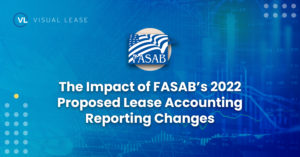

Have you ever wondered how the public can participate in the development of accounting standards? Do you have opinions you would like to share? Many accounting standards governing bodies, such as the Federal Accounting Standards Advisory Board (FASAB or the “Board”), provide some opportunities to do just that.
Whenever an accounting governing body considers new standards, or changes to existing standards, they release exposure drafts for public comment. The FASAB’s exposure drafts, which affect hundreds of federal agencies and the associated public, are posted publicly for commentary. You can find these exposure drafts and the template to submit comments on their website. The FASAB usually offers between 45 and 90 days to submit comments. Visual Lease contributes opinions to many standards, including these recently proposed changes.
The Board considers these comments when deciding whether to move forward with the proposed changes. If interested, you can access the FASAB’s list of active projects and drill into any associated drafts on the FASAB website.
Anyone can submit comments, and the FASAB appreciates all views but particularly looks for comments that include the reasoning behind an opinion (pdf). The Board also appreciates it when the reasoning/concerns include the expected benefits and/or perceived costs of implementing a proposal.
As a lease administration and accounting platform, Visual Lease proactively tracks FASAB projects that impact lease reporting and meeting the standards. An exposure draft to provide clarification and amend SSFAS 54, Leases and SSFAS 60 Omnibus Amendments 2021, was published May 9, 2022 with a comment period that ends Jul 8, 2022. The background includes:
Below is a summary of Visual Lease’s response to this FASAB exposure draft:
For leases without a stated interest rate, originally paragraph 42 of SFFAS 54 and the issued amendment in SFFAS 60, par. 19, required lessees to use the discounted rate from the “lessee’s estimated incremental borrowing rate.” This proposal would require the lessee to use an interest rate “based on marketable Treasury securities with similar maturity to the end of the lease term.”
The added paragraphs 42B and 59B allow for rounding up or down when selecting a marketable Treasury rate term as follows:
“[…] round down to the nearest maturity term with a published rate, interpolate the rate for the period between two published rates, or round up to the nearest maturity term with a published rate. The methodology for selecting marketable Treasury rate terms and related rates, interpolating, and/or rounding up or down should be consistent from period to period.”
The added paragraphs 42C and 59C clarify what to do if the lease goes beyond the longest-published Treasury security term. In this case, the entity should select the longest-published Treasury security term rate.
Using rates based on marketable Treasury securities would help reduce complexity and inconsistencies versus using the estimated incremental borrowing rate. It may also reduce the cost of determining the incremental borrowing rate, which can be costly to ascertain per our experience with private clients adopting the ASC 842 standard. Although we believe using rates based on marketable Treasury securities would make it easier to meet compliance requirements, we also recognize that it may, in certain circumstances, overstate or understate asset values.
We also believe paragraphs 42A (lessee) and 59A (lessor) may need clarification. Under the proposed amendments, the reporting agency has two options to determine its rate. The rate can be either based on a recent Treasury rate or historical average rate if the Treasury security has a similar maturity as the lease term “on the date of initial liability recognition (or the date the liability is updated).” If it is meant that to approximate a rate if a date-specific rate is not available, we believe that in today’s internet environment, detailed historical information is easily available so there likely would not be a need for this.
This proposal also amends SFFAS 54 footnote 11 to paragraph 89 and paragraph 92. The purpose of the amendment clarifies that intragovernmental sale leasebacks are included and must follow the lessee and lessor requirements. Added are references to SFFAS 7 paragraphs 314-315 (intragovernmental) in footnote 11 and the reference to SFFAS 54 paragraphs 37-38 to paragraph 92.
Although we think these suggested changes should add consistency and reduce the complexity of meeting compliance, while avoiding costly estimations of the incremental borrowing rate, we also believe it may overstate or understate the value of some assets. What is your opinion?
Do you agree or disagree with the proposed amendments to address discounting lease liabilities and receivables, as reflected in paragraphs 3-7 (amending par. 42, 47-48, and 59 of SFFAS 54), and the Board’s basis for such proposals? Please provide the rationale for your answer.
Visual Lease, LLC supports the proposed amendments to address discounting lease liabilities and receivables. SFFAS 54’s requirement to use an explicit rate is unchanged; if no explicit rate is stated, an equivalent risk-free rate is expected to be utilized. The terminology provided in the proposed amendments is “based on marketable Treasury securities with similar maturity to the end of the lease term,” in essence the definition of a risk-free rate.
Visual Lease, LLC has observed that in the current private sector implementation of ASC 842, Leases, the new lease accounting standard issued by the Financial Accounting Standards Board (FASB), the use of a risk-free rate rather than a higher incremental borrowing rate (IBR) may have resulted in higher liability values (and therefore asset values) on organizations’ financial position. Additionally, Visual Lease, LLC has observed that this effect could trigger debt service covenants and otherwise cause inconsistency in analytical comparability. However, Visual Lease, LLC believes that, while organizations may have to caveat their financing reporting requirements to lenders to highlight these factors in that QFR 1 may result in less accurate and consistent valuation of liabilities, the suggested methodology does reduce complexity and provides user prescriptiveness in ease of use and availability of input data, thereby facilitating compliance.
Additionally, Visual Lease, LLC observes two impacts regarding the valuation of the lease liabilities and assets in practice: the applicability and accuracy of a specific rate to the entity in question, and the timeliness of the application of that rate. Namely:
Visual Lease, LLC notes that the original wording in SFFAS 54 authorizing entities to use rates based on their own borrowing authority is expressly deleted in this exposure draft, removing calculations from actual costs, and resulting in less accurate valuations. Given the transparency of the Treasury Securities market and rate, and its availability to those entities subject to the FASAB (Federal Accounting Standards Advisory Board) standards, Visual Lease, LLC believes that the suggested changes enhance the process of calculation and result in an” always having up to date information available” situation when creating new or remeasurement calculations for lease accounting. Therefore, Visual Lease, LLC supports the use of risk-free rates.
Additionally, and as a practical matter regarding application of the risk-free rate, the revised guidance allows rounding up or rounding down to the nearest maturity date, or to interpolate between two dates. Extrapolating from the longest term (30 years) would not be permitted. Paragraph 42A references “historical average rates” and appears broad in context and may require further clarification. If it is meant that to approximate a rate if a date-specific rate is not available, we believe that in today’s internet environment, detailed historical information is easily available so there likely would not be need for this.
Do you agree or disagree with the proposed amendments to clarify the applicability of paragraphs 89-92 of SFFAS 54 to intragovernmental sale-leasebacks and the disclosure requirements applicable to them, as reflected in paragraphs 8-9, and the Board’s basis for such proposals? Please provide the rationale for your answer.
Initially, SFFAS 54 was silent regarding sale-leaseback transactions intragovernmental in nature. Visual Lease, LLC agrees with the proposed amendments to clarify the applicability of paragraphs 89-92 of SFFAS 54 to intragovernmental sale-leasebacks and the disclosure requirements applicable to them, as reflected in paragraphs 8-9, and the Board’s basis for such proposals as it clarifies the requirements apply both to public sale-leasebacks and intragovernmental sale-leasebacks for disclosure purpose. Visual Lease, LLC supports this provision because, while not prescribing accounting treatment, it does add clarity and transparency to the amount of intragovernmental sale-leaseback for each reporting entity through disclosure.
As a result of our analysis, Visual Lease, LLC is supportive of both clarifications provided in this exposure draft.
* QFR = Questions for Respondents
*AFR = Answer from Respondents
The SEC is making it known that environmental statements should be the equivalent of financial…
In the ever-evolving landscape of Environmental, Social, and Governance (ESG) reporting within real estate management,…
In the continuing exploration of the intersection between Environmental, Social, and Governance (ESG) reporting and…
Nearly two years after sharing its proposal for climate-related disclosures, the Securities Exchange Commission announced…
In the rapidly evolving landscape of real estate and lease management, the convergence of data…
Managing a complex lease portfolio across real estate and equipment in global business operations presents…